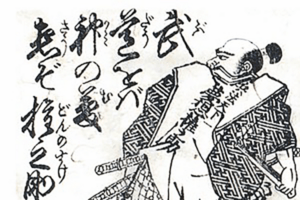Muso Gonnosuke’s Journey

In the world of martial arts, tales spin around legendary figures like Miyamoto Musashi. Yet, there’s a twist in the narrative – Muso Gonnosuke Katsuyoshi, an intriguing character who, according to legends, managed to defeat Musashi using an unusual weapon: a simple wooden stick.
The Mystery of Gonnosuke
Facts about Muso Gonnosuke’s life are sparse, wrapped in stories told by later generations. What we do know is that he studied various martial arts styles before facing off against Musashi in a historic duel.
Musō Gonnosuke Katsuyoshi, born into a samurai family, claimed lineage tracing back to Kiso Kanja No Taiyu Kakumei 1, a loyal follower of the renowned samurai general Minamoto Yoshinaka. Originally named Gonbei, Gonnosuke’s family supposedly descended from the classical period of samurai, with his early days marked by the use of his given name. Gonnosuke embarked on a warrior pilgrimage, following the tradition of musha shugyō 2, a common practice where samurai sought to enhance their martial skills through duels and by learning from various martial arts schools on the road. This journey was a prevalent approach among samurai aiming to refine their martial abilities.
The First Showdown
Around the year 1605, a pivotal moment unfolded in the martial arts world – the first encounter between Musashi and Gonnosuke. However, the details of this historic clash are shrouded in the mists of time, with conflicting accounts adding layers of mystery to the narrative.
According to one version, the confrontation took place in Akashi. In the heat of the moment, Musashi, armed with a stick, faced off against Gonnosuke and his wooden sword. The skirmish was swift, with Musashi’s precise strike leaving Gonnosuke lightly struck between the eyebrows. This version paints a vivid picture of the encounter on the grounds of Akashi.
On the other hand, the Annals of the Niten 3 (Niten ki), a traditional source detailing Miyamoto Musashi’s exploits, offers an intriguing alternative. According to this account, while Musashi was in Edo, a man named Muso Gonnosuke sought a match. Gonnosuke, armed with a bokuto (wooden sword), challenged Musashi, who, at that moment, wielded a willow bow. Musashi swiftly adapted, picking up a stick to counter Gonnosuke’s attack. The outcome was a single, decisive stroke that brought Gonnosuke down.
In this rendition, the setting shifts to Edo, adding a layer of complexity to the historical narrative. The discrepancy in locations highlights the challenges of reconstructing events from centuries past, where oral traditions and various written sources contribute to the rich tapestry of historical accounts.
Retreat and Revelation
Gonnosuke withdrew to a Shinto shrine at Mount Hōman in Chikuzen province, (modern-day, Fukuoka Prefecture), where he would practice daily in perfecting his swordsmanship, praying and performing Shinto purifying rituals for 37 days. It is also said, however, that he spent several years on the road studying other martial arts in various dojos until he ended up at the Shinto shrine. After one of his regular (exhausting) training sessions, he collapsed from fatigue and reputedly had a vision of a divine being in the form of a child, saying to Gonnosuke: “know the solar plexus [of your opponent] with a round stick”. In another version, he had the vision in a dream late at night. He took it upon himself to create the jo deliberately longer than the average katana of the day, 128 cm, as opposed to the sword’s total length of approx. 100 cm, and use that length to his advantage in a fight. Gonnosuke, drawing on his own considerable experience with the spear, longstaff, naginata, and sword, devised a series of jo-techniques for use to counter and defeat a swordsman. Arguably, he also developed techniques to target Musashi’s trade-mark X-block 5 .
Triumph with the Short Staff
Gonnosuke’s second duel remains a mystery. What we do know is that it led to the birth of Shinto Muso-Ryu Jojutsu, a remarkable staff art with five secret methods. This marked a turning point in Gonnosuke’s martial journey.
The outcome of the second duel, or even that a second duel occurred, is not conclusively known. The stick-fighting school he founded maintains that Gonnosuke, now armed with the jo, defeated Musashi through the use of the superior length of the jo to keep Musashi’s swords out of range of Gonnosuke and thus hinder him from using the X-shaped 5 technique effectively. Gonnosuke had Musashi at his mercy but let him live as a way of returning the favor granted in the first duel.
Outside of the stick-fighting schools, the claim that Musashi was ever
